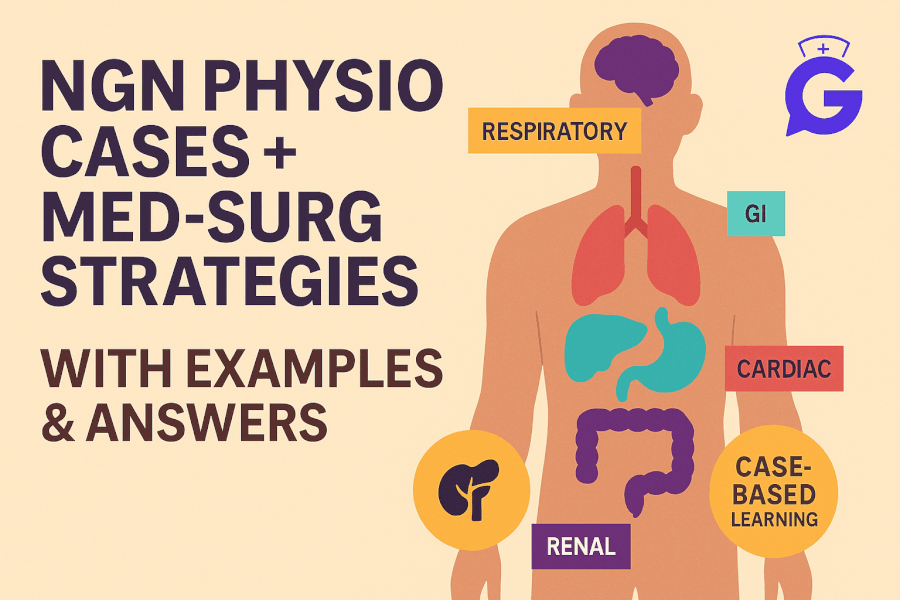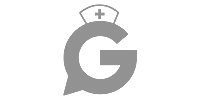Physiological Adaptation is where NGN rewards bedside thinking: reading trends, stabilizing airway and perfusion, and choosing the few interventions that change outcomes. After 20 years in practice and 10 years teaching, I tell my NCLEX tutees the same thing: name the priority aloud first, then pick actions and parameters that prove you made the client safer.
Table of Contents
- How to Use These Case Studies
- Case 1: Acute Pulmonary Edema (HF Exacerbation)
- Case 2: GI Bleed with Hypotension
- Case 3: COPD Exacerbation vs. Pneumonia
- Case 4: Suspected STEMI
- Case 5: Acute Ischemic Stroke—First Hour
- Case 6: DKA—Closing the Gap
- Case 7: Sepsis from Pneumonia
- Case 8: Burns—Early Fluid Resuscitation
- Case 9: Acute Kidney Injury—Contrast Exposure
- Case 10: Increased ICP—Neuro Deterioration
- Scoring & Strategy Refresher
- FAQs
- Further Reading
🎯 Free NCLEX quiz!
Test your knowledge—new quizzes added weekly!
How to Use These Case Studies
- Read the stem once to locate trend words and the time anchor (post-op hour, “worsening,” “after medication”).
- Say the priority in one sentence: “Because of A/B/C, the immediate problem is X.”
- Choose two actions that directly stabilize the priority, then two parameters to verify improvement within 10–30 minutes.
- For stem-reading technique, start with How to Read NGN Case Stems (2025): Clinical Judgment Strategy Guide, then practice formats with NGN Bow-Tie Items (2025) and NGN Matrix/Grid Items (2025).
- If you need a quick blueprint refresher, see NCLEX Categories & Subcategories (Weights, Examples, Practice) and Physiological Adaptation: Key Concepts & Mnemonics.
Case 1: Acute Pulmonary Edema (HF Exacerbation)
Stem (condensed): 72-year-old with history of HFrEF: acute dyspnea, orthopnea, crackles, pink frothy sputum, RR 32, SpO₂ 86% RA, hypertensive, anxious.
Priority problem: Impaired oxygenation due to acute pulmonary edema.
Two best actions:
- Position upright/high-Fowler’s and apply supplemental oxygen per protocol; consider non-invasive ventilation if ordered.
- Prepare/administer diuretic per order; reduce preload/afterload as ordered (e.g., nitrates) while monitoring BP.
Two parameters: SpO₂/respiratory rate; lung sounds and work of breathing.
Rationale: Improve gas exchange immediately; decrease fluid overload to reverse edema.
Faculty tip: Don’t chase numbers—treat the air hunger first. Oxygen and positioning buy time for meds to work.
Case 2: GI Bleed with Hypotension
Stem: Melena and coffee-ground emesis; BP 86/52, HR 122, cool clammy skin; lightheaded on sitting; Hgb pending.
Priority problem: Hypovolemic shock from acute blood loss.
Two best actions:
- Establish/verify two large-bore IVs; begin isotonic fluids per order; type & cross as ordered.
- Maintain NPO, place on oxygen if hypoxic; fall precautions.
Two parameters: BP/MAP and mental status; urine output.
Rationale: Restore circulating volume and perfusion while preparing for definitive management (endoscopy).
Case 3: COPD Exacerbation vs. Pneumonia
Stem: Chronic COPD; now ↑ dyspnea, productive cough with green sputum, RR 28, SpO₂ 88% on 2 L, wheezes and crackles; febrile.
Priority problem: Ventilation/oxygenation compromise with suspected infectious trigger.
Two best actions:
- Titrate oxygen per protocol to target SpO₂; encourage pursed-lip breathing and HOB elevation.
- Sputum culture if ordered and bronchodilators/steroids per order; hydration to loosen secretions.
Two parameters: SpO₂ and RR; breath sounds/work of breathing.
Rationale: Support gas exchange and address likely infection/bronchospasm without delaying stabilization.
Faculty tip: Don’t undertreat hypoxia in COPD. Titrate thoughtfully and reassess—avoid extremes either way.
Case 4: Suspected STEMI
Stem: Crushing substernal chest pain, diaphoresis, nausea; BP 98/62, HR 56, cool clammy; 12-lead pending; nitro available.
Priority problem: Coronary perfusion deficit with high suspicion for myocardial infarction.
Two best actions:
- Activate chest pain protocol; obtain 12-lead ECG and continuous monitoring; oxygen if SpO₂ < 90–92% per policy.
- Administer aspirin per order (if not contraindicated); prepare for nitro per order while monitoring BP.
Two parameters: ECG changes/rhythm; pain level and hemodynamics (BP/HR/MAP).
Rationale: Rapid diagnosis and early antiplatelet support while maintaining perfusion; nitro cautiously with BP/HR trends.
Case 5: Acute Ischemic Stroke—First Hour
Stem: Sudden right-sided weakness and aphasia 45 minutes ago; BP 170/96, glucose 110; last known well documented; CT en route.
Priority problem: Risk of neuronal loss due to cerebral ischemia.
Two best actions:
- Maintain airway and head midline/elevated ~30°; neuro checks; avoid hypotension.
- Establish IV access, draw labs, confirm time last known well; prepare for thrombolytic screening per protocol.
Two parameters: Neuro status (NIHSS/GCS); BP and oxygenation.
Rationale: Protect brain perfusion/oxygenation and expedite eligibility for reperfusion therapy.
Case 6: DKA—Closing the Gap
Stem: Type 1 DM; glucose 520 mg/dL, Kussmaul respirations, fruity breath, dehydration; potassium 5.3 (pre-insulin), bicarb low, anion gap elevated.
Priority problem: Metabolic acidosis/ketosis with dehydration.
Two best actions:
- Begin isotonic IV fluids per order to restore perfusion; start insulin infusion per protocol after potassium check.
- Monitor potassium closely; replace as ordered when it shifts intracellularly with insulin.
Two parameters: BMP (K⁺, bicarbonate), anion gap; glucose trend and mental status.
Rationale: Fluids then insulin resolve ketosis; potassium management prevents dysrhythmias.
Case 7: Sepsis from Pneumonia
Stem: 79-year-old with cough/fever; T 39.1 °C, HR 118, BP 92/54, RR 26, SpO₂ 90% RA, confused; lactate pending.
Priority problem: Septic shock risk with hypoperfusion.
Two best actions:
- Draw cultures (if not done) and start broad-spectrum antibiotics per order; begin IV fluids per protocol.
- Apply oxygen to maintain saturation; close monitoring for escalation.
Two parameters: MAP/BP and urine output; mental status and SpO₂.
Rationale: Source control and perfusion restoration are time-critical.
Practice the sepsis pattern in matrix format with NGN Matrix/Grid Items (2025).
Case 8: Burns—Early Fluid Resuscitation
Stem: 30% TBSA partial-thickness burns (flame); hoarse voice with singed nasal hairs; BP 100/60, HR 128; initial labs pending.
Priority problem: Airway injury risk plus hypovolemia from capillary leak.
Two best actions:
- Assess airway for inhalation injury; prepare for early airway management if signs of obstruction progress.
- Initiate fluid resuscitation using facility protocol (e.g., Parkland formula orders); insert Foley for strict output.
Two parameters: Airway patency/voice changes; urine output and BP/MAP.
Rationale: Secure airway before edema worsens; fluids restore perfusion and guide adequacy by UOP.
Case 9: Acute Kidney Injury—Contrast Exposure
Stem: Post-contrast CT 24 hours ago; urine output 15–20 mL/hr; creatinine rising from 1.0 → 2.0; mild edema; BP stable.
Priority problem: Acute kidney injury with declining filtration.
Two best actions:
- Review meds for nephrotoxins (NSAIDs, ACEi in some contexts) and hold per order; ensure adequate hydration per protocol.
- Daily weights/I&O; collaborate for renal dose adjustments.
Two parameters: Creatinine/BUN and urine output; weight/edema trend.
Rationale: Remove nephrotoxic contributors and preserve renal perfusion while monitoring recovery.
Case 10: Increased ICP—Neuro Deterioration
Stem: Post-TBI patient becomes progressively somnolent; unequal pupils; vomiting; BP ↑ with widening pulse pressure; HR ↓ (Cushing’s triad).
Priority problem: Increased intracranial pressure with risk of herniation.
Two best actions:
- Elevate HOB ~30°, keep head midline; minimize stimulation; maintain airway/oxygenation.
- Notify provider; anticipate orders for hyperosmolar therapy, imaging, and tight CO₂ control per protocol.
Two parameters: Neuro status (GCS, pupils); BP/MAP and oxygenation/ventilation.
Rationale: Positioning and oxygenation reduce ICP while definitive interventions proceed.
Scoring & Strategy Refresher
- Partial credit: You earn points for relevant selections even if not perfect. Over-selecting can subtract credit in some matrices.
- Least-invasive, most effective: Choose actions that change physiology quickly (oxygenation, perfusion, neuro stability).
- Parameters prove success: Select measures that will change soon after your action (SpO₂, MAP, UOP, neuro status).
- Time management: Aim for ~2 minutes per scored interaction. If you reach 3 minutes, commit to the best clinical choice and move on.
For a paced plan that fits NGN practice blocks, see How Long Should I Study for the NCLEX?.
FAQs
How many actions and parameters should I pick?
Usually two and two unless the screen specifies otherwise. Favor interventions that directly stabilize the priority.
Is calling the provider an acceptable action?
Yes, but stabilize what you can now (airway, oxygen, fluids, positioning) before or while you notify.
What if SpO₂ is “okay” but the client is working hard to breathe?
Treat the work of breathing and trend—numbers lag behind physiology. Position, oxygen per protocol, and reassess.
How do I practice without burning out?
Daily micro-sessions (10–20 minutes) plus one longer weekend block. Rotate categories to keep recall fresh.






